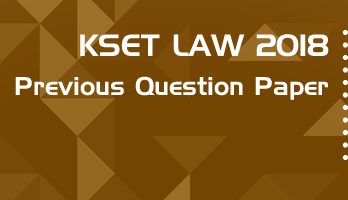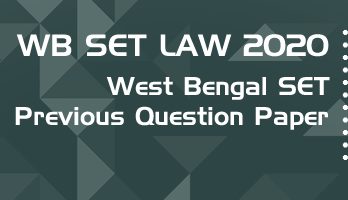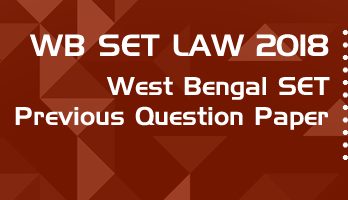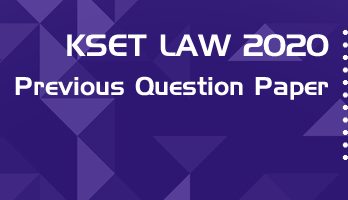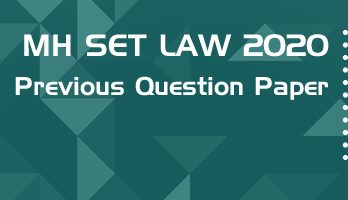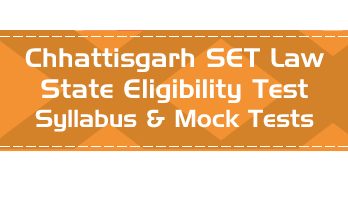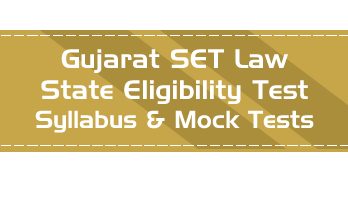- Based on latest Maharashtra State Eligibility Test Law Paper II Syllabus
- Law Subjects Overview Material covering important topics and concepts - 650 page PDF Book
- 50 Full Length Mock Tests - New Pattern Paper II, with 100 questions each
- 50 Mini Practice Mock tests - with 25 questions each
- Unlimited Practice - New Questions in every mock test with every attempt
- Answer choices of all questions shuffled randomly for better practice
- Database of over 9500 MCQs covering the entire syllabus
- Includes new comprehension based questions
- Questions & Answer Choices randomly shuffled in every attempt for better practice
- Accessible 24 x 7 via Smart-Phone browsers and Desktops
"Just wanted to let you know that I have cleared JRF with 99.99th percentile. Thank you for all your help and support that made it possible. " - Kanchan Yadav
"Thank you so much for the UGC NET test series. I finally qualified the exam. It was possible because of the mock test series provided by your team." - Robin Jaiswal
This is the full previous question paper from MH-SET 2017 Paper II Law Subject, i.e. the Maharashtra State Eligibility Test examination conducted in 2017 for eligibility for Assistant Professor posts in Maharashtra & Goa.
The official answer key for this question paper, along with other all recent previous papers and 100 Mock tests / model papers with unlimited practice are included in our online MHSET Law Online Practice Pack.
1# Read Assertion (A) and Reason (R) and with the help of codes given below, point out the correct explanation :
Assertion (A) : The word ‘Socialist’ was added in the Preamble by the Forty-second Amendment to the Constitution.
Reason (R): The addition ‘Socialist’ indicates the incorporation of the Philosophy of Socialism in the Constitution which aims at elimination of inequality of income and status and standard of life.
A# (A) is correct, (R) is false
B# (A) is false, (R) is true
C# Both (A) and (R) are true but (R) is not the correct explanation of (A)
D# Both (A) and (R) are true and (R) is the correct explanation of (A)
2# In India which one of the following is the real guiding factor for the state to meet social needs and for establishment of new social order ?
A# Preamble
B# Directive Principles of State Policy
C# Fundamental Rights
D# Distribution of Power
3# Duty of the parent or guardian to provide opportunities for education of the child or ward between the age of six and fourteen years was incorporated :
A# in the original constitution enacted in 1949
B# by the Forty-second Amendment to the Constitution in 1976
C# by the Eighty-sixth Amendment to the Constitution in 2002
D# by the Ninety-fourth Amendment to the Constitution in 2006
4# Appellate Jurisdiction of the Supreme Court in appeals from High Courts in regard to civil matters pertains only to :
A# Substantial question of law
B# Question of law
C# Question of fact
D# Mixed question of law and fact
5# Which of the following pairs is correctly matched ?
A# Writ of Habeas Corpus : Available against private individuals as well
B# Writ of Quo Warranto: Against subordinate courts only
C# Writ of Certiorari : Against autonomous bodies only
D# Writ of Prohibition : Against public servants only
6# ‘What cannot be done directly cannot be indirectly.’ This doctrine epitomises the doctrine of :
A# Pith and substance
B# Implied powers
C# Ancillary powers
D# Colourable legislation
7# Where the proclamation of emergency is in operation, the President of India may by order declare that the right to move any court for the enforcement of such of the rights conferred by :
A# Part III shall remain suspended
B# Part III (except Article 21) shall remain suspended
C# Part III (except Articles 20 and 21) remain suspended
D# Part III (except Articles 21 and 22) remain suspended
8# Austin’s definition of law cannot be applied to ________
A# International law
B# Constitutional law
C# Hindu law
D# All of the choices
9# For Finnis, ‘natural law’ is the set of _______ in ordering human life and human community.
A# Principles of morality
B# Principles of humanity
C# Principles of practical reasonableness
D# Principles of religion
10# _________ defines law as ‘an ordinance of reason for the common good made by him who has the care of the community and promulgated’.
A# Thomas Aquinas
B# Hobbes
C# Locke
D# Rousseau
11# Duguit is known for his
A# Principle of legality
B# Principle of morality
C# Principle of social solidarity
D# Principle of sociability
12# __________ claimed that criminal law stands to the passion of revenge in much the same relation as marriage to sexual appetite.
A# Sir James Stephen
B# Kenny
C# Bentham
D# Jerome Hall
13# According to Pound, right is a/an ________
A# Interest
B# Claim
C# Capacity
D# All of the choices
14# ‘If international laws were only a kind of morality, the framers of state papers concerning foreign policy would throw all strength on moral argument. But as a matter of fact, this is not what they do. They appeal not to the general feeling of moral rightness, but to precedents, to treaties, and to opinions of specialists. They assume the existence among statesmen and publicists of a series of legal as distinguished from moral obligations in the affairs of nations.’
Who among the following made the aforesaid observation ?
A# John Austin
B# Sir Frederick Pollock
C# Bentham
D# Kelsen
15# Find out incorrect match from the cases listed below :
A# United Nations Administrative Tribunal Case, 1954 : Res judicata as a general principle of law recognized by civilized nations
B# Asylum Case, 1950 : Customary law
C# Temple of Preah Vihear Case, 1962 : Estoppel (preclusion) as a general principle of law recognized by civilized nations
D# North Sea Continental Shelf Cases : Conventional law, 1969
16# When was the Human Rights Council established ?
A# 2006
B# 2008
C# 2000
D# 1998
17# The Minister of Foreign Affairs of Mexico stated in 1930 that his government would no longer issue declarations in the sense of grants of recognition in as much as such a course is an insulting practice. The aforesaid statement is popularly known as
A# Estrada doctrine
B# Principle of collective recognition
C# Stimson doctrine of non-recognition
D# Calvo clause
18# Which of the following Articles of the United Nations Charter requires all members of the UN to settle their international disputes by peaceful means in such a manner that international peace and security, and justice, are not endangered ?
A# Article 2(4)
B# Article 2(3)
C# Article 42
D# Article 51
19# Under which chapter of the UN Charter, the peacekeeping operations are ordinarily taken ?
A# Chapter VI
B# Chapter IX
C# Chapter VII
D# Chapter XI
20# ‘Any child legitimate or illegitimate, one of whose parents is a Hindu, by religion and who has been brought up as a Hindu is a Hindu’. This was held by the Supreme Court in
A# V.V. Giri Vs. Shri Dora
B# Jaya Lakshmi Vs. T. Prakash Rao
C# CWT Vs.R. Shridharan
D# Both V.V. Giri Vs. Shri Dora and Jaya Lakshmi Vs. T. Prakash Rao
21# Holy Quran was revealed to
A# Prophet Adam
B# Prophet Mohammed
C# Prophet Ibrahim
D# It was revealed in parts to all of the Prophets
22# Science of Islamic Jurisprudence is called :
A# Ijmaa
B# Waqf
C# Fiqh
D# Hadith
23# The following commentary is considered to be an authoritative work under Hindu Law in Western India :
A# Vivad Chintamani
B# Vyavahara Mayukha
C# Vira Mitrodaya
D# Vivad Ratnakar
24# Assertion (A) : Under Special Marriage Act, a petitioner can file a petition for divorce on the ground that the respondent had not been heard of as being alive for a period of seven years or more by those persons who would have naturally heard of it, had the party been alive.
Reason (R) : Under the Indian Evidence Act, a person is presumed to be dead if he is not heard as alive for seven years or more by those persons who would naturally have heard of him, had he been alive.
A# Both (A) and (R) are true but (R) is incorrect explanation of (A)
A# Both (A) and (R) are true and (R) is the correct explanation of (A)
B# (A) is true but (R) is false
C# (A) is false but (R) is true
25# I : Under the Divorce Act, where a petition for divorce or judicial separation is based on adultery, the alleged adulterer or adulteress should be made co-respondent unless the alleged adulterer or adulteress is dead, or his or her name is not known to the petitioner or for any reason the court considers that he or she need not be made co-respondent. II : If the adulterer or adulteress is not made a party, it is fatal to the suit and if the trial court has passed a decree, it will be nullity.
A# Both I and II are true and II is the result of I
B# I is true but II is false
C# I is false and II is true
D# Both I and II are false
26# Who defines a contract as ‘an agreement creating and defining obligations between the parties’ ?
A# Sir William Anson
B# John Salmond
C# Blackstone
D# Pollock
27# A letter of acceptance sent by post is lost in transit, then :
A# There is no concluded contract as the acceptance has not been communicated to the proposer
B# There is a concluded contract as the letter of acceptance is put in the course of transmission
C# There is no concluded contract as the letter of acceptance has not come to the knowledge of the proposer
D# All of the choices
28# A contract with a person is valid at the inception but cease to be enforceable subsequently because of Alien enemy nature of a party, the contract then :
A# becomes void when it ceases to be enforceable
B# becomes void ab initio
C# becomes voidable when it ceases to be enforceable
D# remains valid
29# Boulton Vs. Jones case relates to :
A# Mistake as to the identity of the party
B# Mistake as to the nature of transaction
C# Mistake as to the subject-matter
D# Non est factum
30# A’s son forged B’s name to a promissory note. B under threat of prosecuting A’s son obtains a bond from ‘A’ for the amount of the forged note. If ‘B’ sues on this bond, the court :
A# may set aside the bond
B# must not set aside the bond
C# has no jurisdiction in this case
D# None of the choices
31# The maxim ‘lex non cogit ad impassibilia’ means :
A# An agreement to do an impossible act in itself is void
B# Law does not compel a man to do what he cannot possibly perform
C# Impossibility to known to promisor alone
D# All of the choices
32# The rule laid down in Hadley Vs. Baxendalo (1854) is:
A# Damages arising in the usual course of things
B# Damages to be in reasonable contemplation of the parties
C# Principle of foreseeability
D# Both, Damages arising in the usual course of things and Damages to be in reasonable contemplation of the parties
33# Which amongst the following is not an essential element to constitute tort ?
A# A wrongful act by the defendant
B# Legal damage to the plaintiff
C# Breach of express provision of law
D# The wrongful act must be of such nature as to give rise to a legal remedy
34# Which amongst the following is not the valid defense for the action of tort ?
A# de minimus non curat lex
B# salus populi suprema lex
C# scienti non fit injuria
D# vis major
35# Which of the following maxims underlines the principle of vicarious liability ?
A# Qui facit per alium facit per se
B# Volenti non fit injuria
C# Salus populi suprema lex
D# Actio personalis moritur cum persona
36# Which amongst the following maxims best explains the doctrine of ‘Remoteness of Damage’ ?
A# Actio personalis moritur cum persona
B# Injuria non remota causa sed proxima spectatur
C# Qui facit per alium facit per se
D# Rex est major singulis, minor universis
37# The onus of proving contributory negligence lies on :
A# plaintiff
B# Defendant
C# It can be inferred from the facts of the case
D# The court can judge the negligence during trial
38# In which of the following cases the court has held that the rule of Ryland Vs. Fletcher which was laid down in the 19th century did not fully meet the need of a modern industrial society and introduce the new concept of ‘Absolute liability’
A# Indian Airlines Vs. Renu Gupta AIR 2007 (NOC) 116
B# National Insurance Co. Ltd. Vs. Manohar Lai Batra 2004 CPR 78 (NC)
C# State of J and K Vs. Altaf Ahmad Gani AIR 2004 NOC 178
D# M.C. Mehta Vs. Union of India AIR 1987 SC 965
39# The maxim ‘actus non facit reum nisi mens sit rea’ means :
A# There can be no crime without a guilty mind
B# Crime has to be coupled with guilty mind
C# Crime is result of guilty mind
D# In crime intention is relevant, motive is irrelevant
40# Nothing is an offence which done by a child under years of age.
A# Six
B# Seven
C# Eight
D# Nine
41# The Right of Private Defence is :
A# unrestricted
B# subject to other provisions of IPC
C# subject to the restrictions contained in Section 99 of IPC
D# Subject to the restrictions contained in the Section 100 of IPC
42# Whenever force or violence is used by unlawful assembly, or by any members thereof, in prosecution of the common object of such assembly, every member of such assembly is guilty of the offence of
A# Affray
B# Rioting
C# Rioting and Affray both
D# None of the choices
43# ‘A’ makes an attempt to steal some jewels by breaking open a box, and finds after so opening the box, that there is no jewel in it. He is guilty of an offence under :
A# Section 508
B# Section 509
C# Section 510
D# Section 511
44# Forceful sexual intercourse by husband with his wife during separation is punishable under Section
A# 376-A IPC
B# 376-B IPC
C# 376-C IPC
D# 376-D IPC
45# Which one of the following was not overruled by the Constitution Bench of the Supreme Court in Bangalore Water Supply and Sewerage Board Vs. Rajappa while interpreting the definition of ‘Industry’ defined under the Industrial Disputes Act, 1947 ?
A# State of Bombay Vs. Hospital Mazdoor Sabha
B# Madras Gymkhana Club Employees’ Union Vs. Madras Gymkhana Club
C# University of Delhi Vs. Ram Nath
D# Management of Safdarjung Hospital Vs. Kuldip Singh Sethi
46# Assertion (A) : The Industrial Disputes Act, 1947 provides for collective bargaining for resolving industrial disputes.
Reason (R) : This can be established with the support, inter alia, of the definition of ‘settlement’ provided under Section 2(p) therein :
A# Both (A) and (R) are correct
B# Both (A) and (R) are incorrect
C# (A) is correct but (R) is incorrect
D# (A) is incorrect but (R) is correct
47# To be a member of a registered Trade Union under the Trade Unions Act, 1926, a workman must attain the age of years.
A# 18
B# 16
C# 15
D# 14
48# Under Section 18 of the Trade Unions Act, 1926, a trade union leader or an office bearer of a registered trade union has immunity from
A# being transferred
B# being proceeded against his misconduct
C# civil proceedings in certain cases
D# being proceeded against his deliberate trespass
49# Lack of supply of raw materials for the time being can be the cause for _______ as per the Industrial Disputes Act, 1947.
A# Closure
B# Lockout
C# Both Closure and Lockout
D# Lay off
50# In which of the following cases, the Supreme Court ruled that ‘mere illegality of strike does not per se spell unjustifiability’ ?
A# Statesman Ltd. Vs. Their Workmen
B# Gujarat Steel Tubes Vs. Gujarat Steel Tubes Mazdoor Sabha
C# L. Chandra Kumar Vs. Union of India
D# T.K. Rangrajan Vs. Government of Tamil Nadu and others
The official answer key for this question paper, along with other all recent previous papers and 100 Mock tests / model papers with unlimited practice are included in our MH SET Law Online Practice Pack.
- Based on latest Maharashtra State Eligibility Test Law Paper II Syllabus
- Law Subjects Overview Material covering important topics and concepts - 650 page PDF Book
- 50 Full Length Mock Tests - New Pattern Paper II, with 100 questions each
- 50 Mini Practice Mock tests - with 25 questions each
- Unlimited Practice - New Questions in every mock test with every attempt
- Answer choices of all questions shuffled randomly for better practice
- Database of over 9500 MCQs covering the entire syllabus
- Includes new comprehension based questions
- Questions & Answer Choices randomly shuffled in every attempt for better practice
- Accessible 24 x 7 via Smart-Phone browsers and Desktops
"Just wanted to let you know that I have cleared JRF with 99.99th percentile. Thank you for all your help and support that made it possible. " - Kanchan Yadav
"Thank you so much for the UGC NET test series. I finally qualified the exam. It was possible because of the mock test series provided by your team." - Robin Jaiswal


